Oct. 14 to Oct. 20
The battle began when 17 media outlets issued a joint statement slamming the China Times on Oct. 18, 1982. A day earlier, the newspaper had announced on its front page the arrival of Nobel Prize-winning Russian writer Aleksander Solzhenitsyn to Taiwan, detailing his visit on page 3.
“Anti-communist writer visits adamantly anti-communist country, his freedom is proof of the freedom and democracy of Taiwan,” ran one of the headlines.
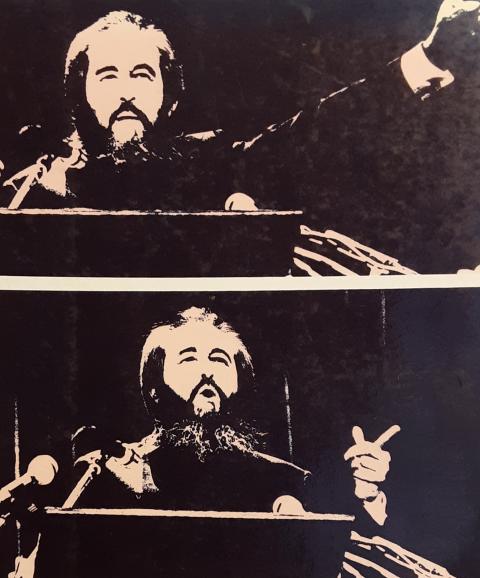
Photo courtesy of National Central Library
The paper’s rivals were furious that it jumped the gun despite them collectively promising to not publish anything until Solzhenitsyn made his first public appearance.
“Even though our reporters watched him enter the country ... the majority of newspapers, television and radio stations refrained from publishing anything per the agreement,” the statement read. “But only the China Times violated the agreement, ‘exclusively’ publishing the news of his arrival. This is very unfair because they took advantage of us keeping our word to their own benefit ...”
The China Times issued its own statement the next day, claiming that it had never agreed to the terms, instead criticizing Independence Evening Post (自立晚報) journalist Frank Wu (吳豐山), who coordinated Solzhenitsyn’s visit, for disrespecting press freedom by making such a request. They were especially incensed that as punishment, Wu announced that they would refuse to provide the China Times any press releases or photos and would ban them from attending Solzhenitsyn’s speech the following week.
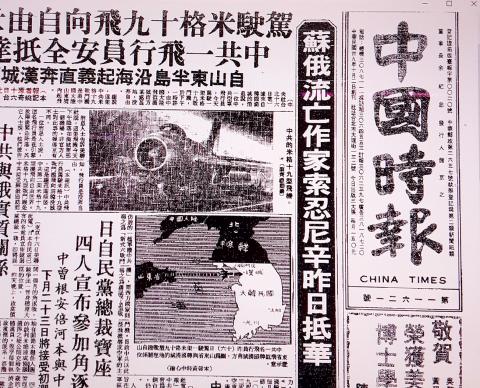
“Mr. Solzhenitsyn is a man who upholds freedom, especially freedom of speech. We hope that he can fully experience the freedom that is enjoyed in [Taiwan]. We believe that he, as well as our citizens, will not accept any agreement that violates this spirit,” the paper fired back.
SECRETIVE VISIT
At that time, Solzhenitsyn was living in exile in the US. He was an outspoken critic of the Soviet Union, especially its gulag labor camp system under which he spent 11 years, and his work won him the Nobel Prize in Literature in 1970. After a failed KGB assassination attempt, Solzhenitsyn was expelled from his home country in 1974.
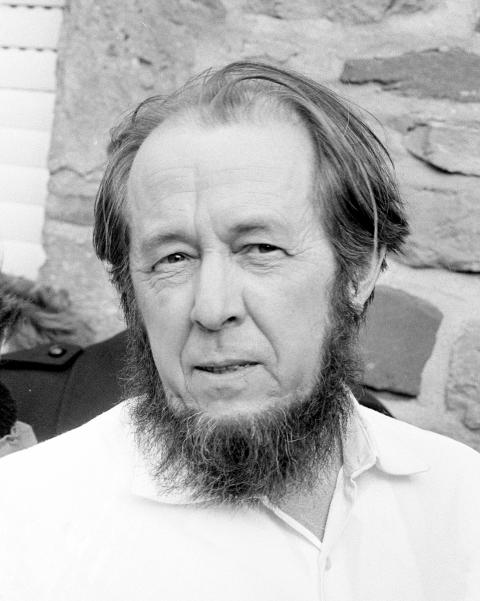
Photo courtesy of Wikimedia Commons
The fact that he agreed to visit Taiwan was big news, as the nation was floundering diplomatically, clinging on to the last vestiges of its claims as “Free China” and a beacon of anti-communism in Asia.
According to Frank Wu, the Wu San-lien Award Foundation first reached out to Solzhenitsyn in June 1981. Three months later, the author agreed to visit on the condition that everything be kept secret until his first public appearance in Taiwan. All correspondence was personally delivered by Wu San-lien’s sons or daughters-in-law as they shuttled between Taiwan and the US. Even so, Wu was not to refer to Solzhenitsyn by name in the letters, but as “Professor Smith.”
After a year of back and forth, Wu was informed on Oct. 9, 1982 that Solzhenitsyn would be arriving in exactly a week. On Oct. 13, Wu gathered members of the local and foreign press, instructing them not to publish anything until Solzhenitsyn gave the green light.
But news photographers descended on the airport to await his arrival on Oct. 16. Wu made them promise not to publish the photos until later, to shoot from a distance and not use flash. The latter request was ignored as the photographers mobbed Solzhenitsyn. He was visibly upset, Wu recalls.
On Oct. 17, Wu had no choice but to inform the writer that the China Times had already reported the news of his arrival. Since English was neither man’s strong suit, it took three hours for Wu to convince the writer that it was the press who disobeyed his instructions. At that point, Solzhenitsyn decided that they might as well announce to the entire nation his arrival, but strongly reiterated his desire to not be bothered.
MEDIA FRENZY
Reporters quickly found out where the writer was staying, and booked rooms in the hotel. One even managed to scale the roof and enter Solzhenitsyn’s room. He refused to answer any questions before she was taken away.
By Oct. 19, both parties realized that it was futile to resist the persistent reporters, and a “motorcade” of about 20 press vehicles followed Solzhenitsyn on his way south, even running red lights to keep up. The first stop was Taichung, where Solzhenitsyn was made an honorary citizen and given a key to the city.
It was a circus wherever he went, as everyone wanted to catch a glimpse of the “big-bearded Russian who appeared in the news everyday,” Wu writes. When Solzhenitsyn asked why he was so popular, his translator told him that the “citizens of Free China’s way of life and attitudes toward personal freedom are in line with his, so they especially welcome him.”
Taiwan was, in fact, under authoritarian rule.
Meanwhile, the newspaper war continued, as the United Daily News accused the China Times of cutting in line in the motorcade, while the China Times pointed fingers at the China Daily News (中華日報).
By the time they reached Kaohsiung, the motorcade had increased to 43 cars. Wu writes that the writer turned down all invitations and gifts by various organizations except a preview of the movie Portrait of a Fanatic (苦戀) that was highly critical of the Cultural Revolution.
On Oct. 23, Solzhenitsyn made his speech, To Free China (給自由中國), where he praised and encouraged Taiwan’s anti-commmunist spirit.
“In China, thanks to a wide strait, a fragment of the former state became the Republic of China on Taiwan, which, for a third of a century, proved to the world what heights of development could have been reached if the whole of China had not fallen under the yoke of Communist hands,” he begins.
He goes on to slam the UN’s exclusion of Taiwan, and especially the US for abandoning the nation for communist China. Finally, he urges Taiwanese to stay vigilant despite a surging economy:
“Do not permit the youth of your country to become soft and placid, to be slaves to material goods, until finally they will prefer slavery and captivity to the struggle of freedom. You are not a serene, carefree island; you are an army, constantly under the menace of war.”
In the end, Solzhenitsyn was able to quietly sneak out of Taiwan. Wu respected his wishes, sending a press release about his departure to the Central News Agency 24 hours after he left.
Taiwan in Time, a column about Taiwan’s history that is published every Sunday, spotlights important or interesting events around the nation that have anniversaries this week.
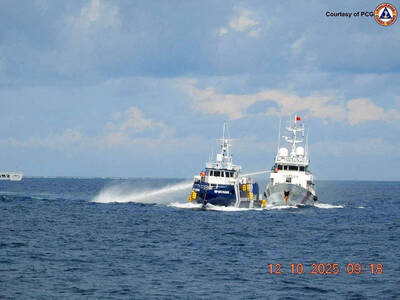
Many people noticed the flood of pro-China propaganda across a number of venues in recent weeks that looks like a coordinated assault on US Taiwan policy. It does look like an effort intended to influence the US before the meeting between US President Donald Trump and Chinese dictator Xi Jinping (習近平) over the weekend. Jennifer Kavanagh’s piece in the New York Times in September appears to be the opening strike of the current campaign. She followed up last week in the Lowy Interpreter, blaming the US for causing the PRC to escalate in the Philippines and Taiwan, saying that as
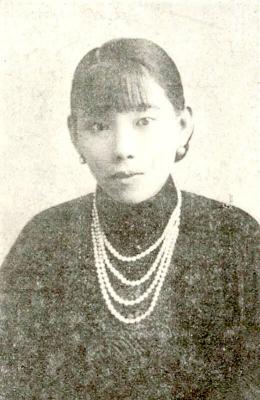
Nov. 3 to Nov. 9 In 1925, 18-year-old Huang Chin-chuan (黃金川) penned the following words: “When will the day of women’s equal rights arrive, so that my talents won’t drift away in the eastern stream?” These were the closing lines to her poem “Female Student” (女學生), which expressed her unwillingness to be confined to traditional female roles and her desire to study and explore the world. Born to a wealthy family on Nov. 5, 1907, Huang was able to study in Japan — a rare privilege for women in her time — and even made a name for herself in the

This year’s Miss Universe in Thailand has been marred by ugly drama, with allegations of an insult to a beauty queen’s intellect, a walkout by pageant contestants and a tearful tantrum by the host. More than 120 women from across the world have gathered in Thailand, vying to be crowned Miss Universe in a contest considered one of the “big four” of global beauty pageants. But the runup has been dominated by the off-stage antics of the coiffed contestants and their Thai hosts, escalating into a feminist firestorm drawing the attention of Mexico’s president. On Tuesday, Mexican delegate Fatima Bosch staged a

Taiwan can often feel woefully behind on global trends, from fashion to food, and influences can sometimes feel like the last on the metaphorical bandwagon. In the West, suddenly every burger is being smashed and honey has become “hot” and we’re all drinking orange wine. But it took a good while for a smash burger in Taipei to come across my radar. For the uninitiated, a smash burger is, well, a normal burger patty but smashed flat. Originally, I didn’t understand. Surely the best part of a burger is the thick patty with all the juiciness of the beef, the